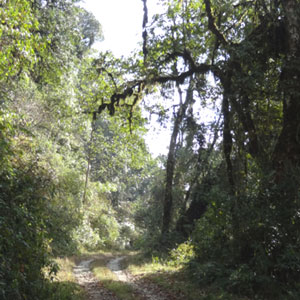Magazine | Voyages
Séjour ornithologique dans l’Arunachal Pradesh (Inde) du 15 au 23/01/2015

Sentier forestier dans l’Eaglenest Wildlife Sanctuary, Arunachal Pradesh (Inde), janvier 2015.Photographie : Benoît Forget
Introduction
L’Arunachal Pradesh est un état indien peu connu situé à l’extrémité nord-est du pays. Il est frontalier avec le Bhoutan à l’ouest, la Chine au nord et le Myanmar (Birmanie) à l’est. Il s’étend des hautes montagnes de l’extrémité orientale de l’Himalaya à la vallée du Brahmapoutre. Les contreforts de l’Himalaya sont en partie couverts de forêts très riches, dont 3 500 km² sont protégées au sein du complexe d’aires protégées de Kameng qui comprend l’Eaglenest Wildlife Sanctuary. Ce secteur protégé de 217 km² est peu connu : il est pourtant considéré comme étant l’un des dix sites ornithologiques les plus riches du monde, aux côtés entre autres du parc national de Manu au Pérou, de la vallée de Mindo en Équateur et du parc national de Taman Negara et de la vallée de Danum en Malaisie. C’est en tout cas l’un des meilleurs sites indiens pour découvrir l’avifaune himalayenne, avec plus de 450 espèces d’oiseaux recensées.
Benoît Forget a séjourné dans l’Arunachal Pradesh du 15 au 23/01/2015 : il a notamment visité l’Eagle Nest Wildlife Sanctuary, les cols de Mandala et de Sela et la vallée de Sangti. Il était guidé sur le terrain par Lobsang Tsering, membre de l’Arunachal Pradesh Art & Culture Eco-Tourism Society (APACETS). Les visiteurs étaient peu nombreux, mais il a tout de même rencontré Bikask Kalita, le fondateur de la jeune revue naturaliste « The Wild Trail », dans l’Eaglenest Wildlife Sanctuary. Benoît Forget a rédigé un rapport de voyage riche en renseignements pratiques. Nous remercions Gaurav Kataria (APACETS) et Bikask Kalita pour leurs photos.
Abstract
The Arunachal Pradesh a little-known Indian state located at the northeastern tip of the country. It is bordered with Bhutan to the west, China to the north and Myanmar (Burma) to the east. It stretches from the high mountains of the eastern end of the Himalayas to the Brahmaputra valley. The Himalayan foothills are partly covered by rich forests: 3500 km² are protected within the Kameng protected areas complex which includes the Eaglenest Wildlife Sanctuary.This protected area of 217 km² is little known: it is nevertheless considered as one of the ten richest birding sites in the world, which also include the Manu National Park in Peru, the Mindo valley in Ecuador and the Taman Negara National Park and the Danum Valley in Malaysia. It is anyway one of the best Indian areas to watch Himalayan birds, with over 450 recorded bird species.
Benoît Forget stayed in Arunachal Pradesh from 15 to 23/01/2015: he visited the Eaglenest Wildlife Sanctuary, the Mandala and Sela passes and the Sangti Valley. He was guided in the field by Lobsang Tsering, a member of the Arunachal Pradesh Art & Culture Eco-Tourism Society (APACETS). Visitors were few at the time of his trip but he nonetheless met Bikask Kalita, the founder of the young naturalist magazine « The Wild Trail », in the Eaglenest Wildlife Sanctuary.
Benoît Forget wrote a trip report full of useful informations. We thank Gaurav Kataria (APACETS) and Bikask Kalita for their photos.
Poursuivez la lecture de cet article, en vous abonnant dès maintenant !
Découvrez les Archives d’Ornithomedia.com
Pour seulement 10,00 €TTC/an (ou 6,00 € les 6 mois)
Profitez de plusieurs centaines d’articles en accès illimité et sans aucun engagement.
Compléments
Contacts
- Benoît Forget – Courriel : forgetbenoit@yahoo.fr
- Basanta Boro (chauffeur) – Courriel : basantaboro77@gmail.com – Tel : +91 9402456058 – Page Facebook
- Lobsang Tsering (guide) – Courriel : lobsangtsering56@gmail.com – Tel : +918729947167 – Page Facebook
- Gaurav Kataria (photographe à l‘Ae Travels Private Limited) – Tel : +91-9999030436 – Page Facebook
- Bikask Kalita (photographe et créateur de la revue “The Wild Trail”) – Page Facebook
À lire aussi sur Ornithomedia.com
- Les oiseaux du parc national de Keoladeo (Inde)
- Observer les Grues demoiselles à Kheechan (Inde)
- Synthèse du suivi 2013 de la migration automnale des rapaces à Thoolakharka (Népal)
- Observer les oiseaux au Sichuan (Chine)
- Bilan 2012 du suivi de la migration des rapaces à Thoolakharka (Népal)
- Première observation du Vautour indien au Népal
- Observer les vautours et les aigles dans la décharge de Jor Beed
- Un espoir pour les vautours du sous-continent indien
À lire sur le web
- Le site web du department of Environnment and Forest (gouvernement de l’Arunachal Pradesh) : http://arunachalforests.gov.in
- Le site web de la Bombay Natural History Society : www.bnhs.org
- Le site web de la revue « Wild Trail » : wildtrail.org/index.php
Ouvrages recommandés
- Birds of Northern India de Richard Grimmett (Auteur), Tim Inskipp (Auteur)
- Birds of India: Pakistan, Nepal, Bangladesh, Bhutan, Sri Lanka, and the Maldives de Richard Grimmett, Carol Inskipp et Tim Inskipp (2012)
- Handbook of the Birds of India and Pakistan de Salim Ali (Auteur), Ripley S. Dillon (Auteur)
- A Field guide to the birds of China de John MacKinnon et Karen Phillipps
- Field Guide to the Birds of South-East de Craig Robson
- Birds of South Asia: The Ripley Guide de Pamela C. Rasmusen et John C. Anderton
- Birds of South-East Asia de Norman Arlott
- Birds of East Asia. Eastern China, Taïwan, Korea, Japan and Eastern Russia de Brazil M. (2009)
Sources
- B. Forget (2015). North-east india (short) birding trip report – Eaglenest – Mandala & Sela Pass – Sangti, 15-23 janvier 2015. Date : 28 septembre. 14 pages. www.birdingpal.org/tours/IndiaItinerary.htm
- Sanjay Bhatnagar’s Home Page. Eaglenest Biodiversity Project. www.aoc.nrao.edu/~sbhatnag/Nature/warunachal/wapMiscEaglenestBP.htm
- Ramana Athrey. Eaglenest Biodiversity Project – I (2003 – 2006). Conservation Resources for Eaglenest Wildlife Sanctuary. www.iiserpune.ac.in
- Henk Hendriks (2009). Birding report to North East India 17 April – 9 May 2009. Birding2Asia. www.birding2asia.com/TripReports/NorthEastIndiaHendriks09.html




Aucun commentaire sur ce sujet
Participer à la discussion !